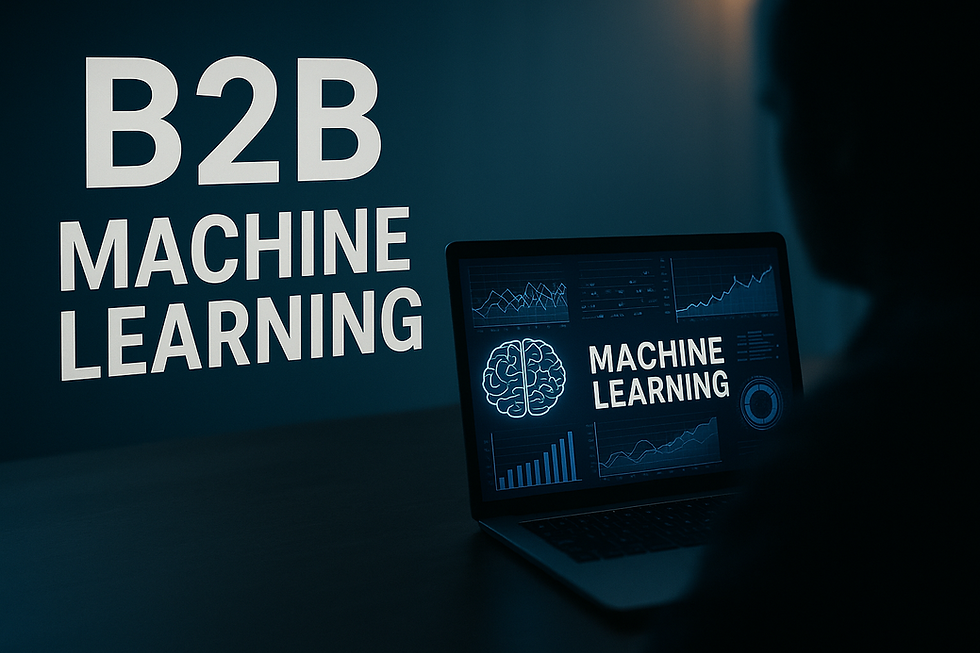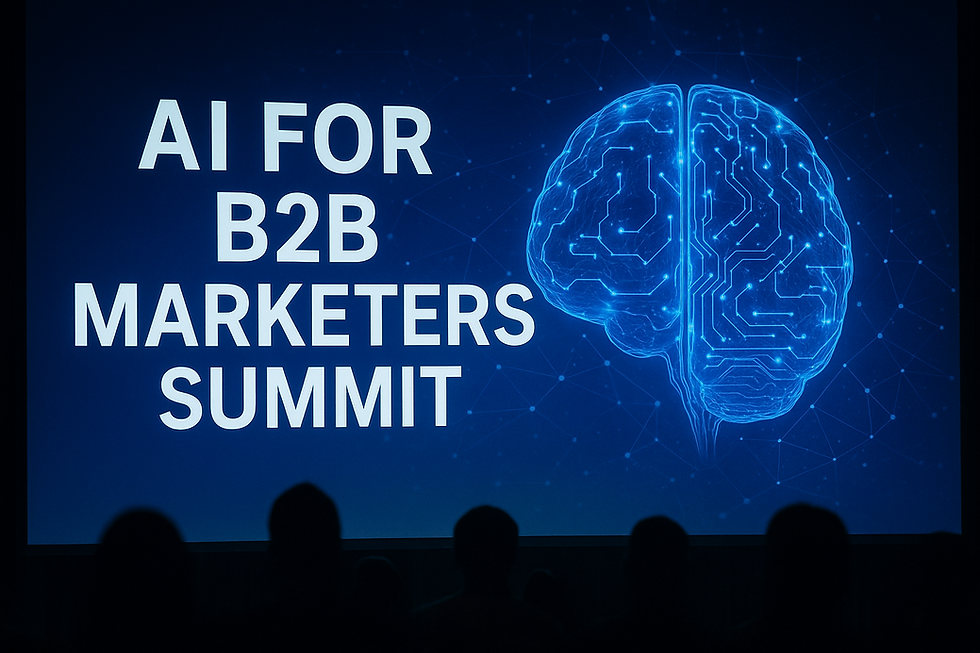B2B Machine Learning: The Data Driven Uprising Reshaping Sales, Forever
- Muiz As-Siddeeqi

- Aug 20
- 5 min read

Somewhere between strategy decks, cold email campaigns, and millions of unread CRM fields, B2B sales reached a tipping point. The traditional ways weren’t just inefficient—they were brutally disconnected. We weren’t selling to logos. We were selling to humans. But our systems? They treated everyone the same. Generic scoring. Gimmicky playbooks. Gut-feeling segmentation.
That’s where the data cracked open. And machine learning walked in.
This blog isn’t about hypothetical algorithms. It’s about real sales teams, real buyers, and real revenue transformations—backed by cold, hard data and case studies that are changing how B2B deals get done in 2025.
Bonus: Machine Learning in Sales: The Ultimate Guide to Transforming Revenue with Real-Time Intelligence
Bonus Plus: AI for Complex B2B Deal Prediction
The Industrial Shift from Instinct to Intelligence
In 2023, McKinsey reported that B2B companies using AI-driven analytics saw up to 50% improvement in lead quality and 5–10% boost in topline revenue [Source: McKinsey, “State of AI in 2023”]. That’s not just optimization. That’s reinvention.
Machine learning is no longer “good to have.” It’s becoming existential for B2B sellers trying to keep pace in a world where buyer behaviors shift by the second, data volumes are overwhelming, and human decision-making simply can’t keep up.
Why B2B Needed Machine Learning More Than B2C Ever Did
Let’s break it emotionally and practically:
B2B deals are longer and more complex.
Multiple stakeholders = more friction points.
Buyer intent is often hidden under layers of browsing, silence, and hesitation.
Human reps can’t read hundreds of data points per buyer. ML can.
And let’s face it: most B2B CRMs are graveyards. Full of outdated contacts, misclassified accounts, and forgotten MQLs. Machine learning doesn’t just predict better. It cleans, enriches, segments, scores, and learns—at scale.
What Exactly Is B2B Machine Learning?
B2B Machine Learning is the use of predictive, supervised, and unsupervised learning models to analyze buyer behaviors, forecast deal outcomes, optimize touchpoints, and automate decision-making across the sales cycle. This includes:
Predicting which leads are ready to buy
Forecasting revenue with 90%+ accuracy
Personalizing outreach messages at scale
Recommending optimal pricing and discounts
Prioritizing accounts based on intent signals
It’s not buzz. It’s math. Trained on billions of data points and deployed in seconds.
Case Study That Shook the Industry: Autodesk
Autodesk, a global software company, implemented a machine learning-powered lead scoring model in collaboration with Lattice Engines. What happened?
400% increase in MQL-to-SQL conversion
2x deal win rate
25% reduction in sales cycle time[Source: Lattice Engines, Autodesk Case Study]
This wasn’t theoretical. This was cold math applied to real data—and it paid off.
The Critical ML Applications in B2B Sales (That Are Already Making Millions)
Let’s go deeper than usual. Not just “lead scoring” and “chatbots.” We’re talking about serious B2B revenue machines:
1. Predictive Deal Scoring
Instead of waiting months to know which deals will close, ML models analyze past deal patterns, behavior logs, rep actions, and even calendar data to predict deal success probability.
Real-World Use: Gong.io’s AI model can predict deal success with up to 84% accuracy based on conversation data [Source: Gong.io Sales Benchmark Report 2024].
2. Behavioral Intent Recognition
Traditional B2B intent signals? Weak. Today, ML models track micro-behaviors like:
Time spent on competitor pages
Multiple visits to pricing pages
Logins without purchases
Email opens with clickless scrolls
Real-World Use: 6sense reports that companies using ML-based intent scoring see a 20–40% lift in pipeline velocity [Source: 6sense Customer Impact Study 2024].
3. AI-Powered Content Personalization
B2B buyers aren’t interested in “Dear FirstName” anymore. ML algorithms generate personalized email variants based on firmographics, technographics, psychographics, and even tone preferences.
Real-World Use: PathFactory’s ML-driven content delivery engine increased lead engagement time by 3.2x for B2B clients in 2023 [Source: PathFactory Benchmark Report].
4. Pricing Optimization with ML
Dynamic pricing isn’t just for ecommerce. B2B ML pricing engines (like Pricefx and Zilliant) adjust quotes in real-time based on:
Deal history
Customer size
Product mix
Time of year
Real-World Result: Zilliant helped a global manufacturer increase EBITDA by $16M in one year through AI price optimization [Source: Zilliant Case Studies, 2024].
The Cold Hard Truth: Manual Segmentation Is Dead
For decades, B2B marketers segmented based on static fields: industry, company size, maybe a vertical. But real buyers? They don't behave according to drop-down menus.
Machine learning creates behavioral clusters based on how people browse, buy, and interact. It identifies hidden patterns your marketing team didn’t even know existed.
Gartner Prediction: By 2026, 65% of B2B companies will shift from persona-based segmentation to ML-driven micro-clustering for demand generation [Source: Gartner AI & B2B Trends 2025].
The Rarely-Talked About: Predicting Churn in B2B SaaS
We talk a lot about new logos. But what about keeping them?
ML models trained on churn data (e.g. drop in usage, support tickets, payment delays) can flag at-risk accounts months before a human CSM would notice.
Real Example: Gainsight’s AI churn model helped one SaaS client reduce churn by 17% within 6 months [Source: Gainsight Customer Impact Review].
Data Unlocked: Why This Works Now (And Didn’t Before)
Let’s get real. Machine learning isn’t new. So why is B2B only now catching up?
Explosion in behavioral data (CRM, email, chat, call logs, etc.)
Cloud-native tools (no more on-premise nightmares)
Open-source ML libraries (e.g. Scikit-learn, TensorFlow)
Cheaper compute power (thanks to AWS, Azure, GCP)
It’s not just about having data. It’s about the ability to act on it.
Who’s Using B2B ML in 2025? Not Just the Fortune 500.
While Salesforce, Oracle, and Adobe are obvious adopters, mid-market and even startups are using ML tools like:
Clari for revenue forecasting
People.ai for activity intelligence
Outreach Kaia for sales call insights
Chili Piper for lead routing
Drift for conversational AI
This isn’t a luxury tech stack. It’s the new standard.
The Human Side: ML Doesn’t Replace Sales. It Reinforces It.
There’s a fear that AI will replace reps. That’s false.
The real transformation? ML augments the rep:
Reps spend less time on admin
They follow up on better leads
They get notified when intent spikes
They have access to real-time call coaching
AI does the heavy lifting. Humans close the deal.
The Dirty Secret: Many Companies Are Still Not Ready
Despite the rise, over 60% of B2B companies have no machine learning in their sales stack yet [Source: Forrester, 2024 AI in Sales Readiness Report].
Why? Because:
Data is dirty
Tech stacks are fragmented
Internal buy-in is slow
Teams are afraid of change
But here’s the opportunity: the ones who get it right early—will dominate.
What It Takes to Deploy B2B Machine Learning Today
If you’re building a B2B ML strategy, here’s the real, grounded checklist:
Centralized CRM and behavioral data
Clean, labeled historical datasets
Defined business outcomes (not vague AI goals)
Pilot use case (like churn prediction or lead scoring)
Vendor partnerships or in-house ML teams
Internal champions in RevOps or Sales Enablement
You don’t need a PhD. You need a plan.
This Is Not a Trend. It’s a Revolution.
We’re not watching the next wave of B2B sales. We’re living it.
And it’s not about hype. It’s about results. Revenue that’s more predictable. Pipelines that are more focused. Buyers who are finally understood.
Machine learning isn’t replacing the B2B salesperson. It’s making them unstoppable.
Let’s End on a Thought That’s 100% Real
B2B used to be about who shouted the loudest, had the best Rolodex, or pushed the hardest.
Now? It’s about who listens to the data best. And that… is machine learning’s job.

$50
Product Title
Product Details goes here with the simple product description and more information can be seen by clicking the see more button. Product Details goes here with the simple product description and more information can be seen by clicking the see more button

$50
Product Title
Product Details goes here with the simple product description and more information can be seen by clicking the see more button. Product Details goes here with the simple product description and more information can be seen by clicking the see more button.

$50
Product Title
Product Details goes here with the simple product description and more information can be seen by clicking the see more button. Product Details goes here with the simple product description and more information can be seen by clicking the see more button.






Comments